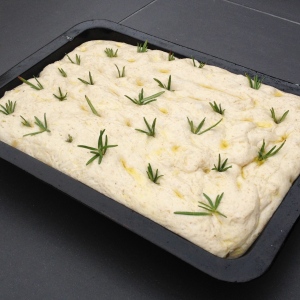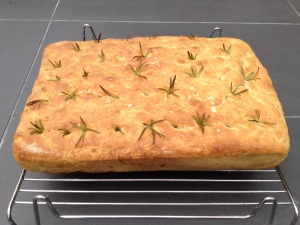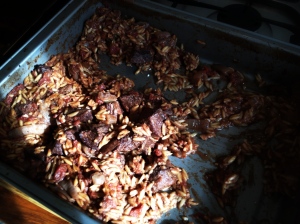Most recipes for pizza dough include olive oil (or some other oil) and sugar. And many recipes for bread also include oil and sugar, usually unnecessarily, leading many people to think they are some kind of magical ingredients without which the bread will not rise / be edible / too few holes / too many holes, etc!
The first thing that strikes a novice on a good bread course is the ingredient list…
The instructor will usually show the students the ingredients list from a packet of commercial white bread, the four main ingredients being supplemented by a host of others designed to allow the Chorleywood process to do its funky thing. After a day of bread making you soon find out that the four main ingredients will do almost anything you want. Sugar can help develop the crust a little, as can steam in the oven. Oil can help control texture by shortening the gluten strands, and can make the bread easier to cut for those with weak arms (!). But it can also contribute to the flavour and keeping time, so it shouldn’t be ruled out without some research, experimentation and consideration.
However, pizza dough isn’t being used to make conventional bread, so maybe the same rules don’t apply? I asked a friend who works in northern Italy if she knew what the Italians did. She spoke to the local Piazzaiolo, and sent this reply to me:
They ALWAYS use olive oil in the pastry, but here “North” it depends on the taste, it’s not a main ingredient however, (but in the South it is), and he still puts in a very small quantity. He tells me that important thing is you should make sure the yeast is fresh and melt it down “just before” you add it to the pastry and not earlier, it should rise inside the flour.
A quick sampling of internet recipes suggests most people use oil and sugar. The first Google result for ‘pizza dough’ is from Jamie Oliver’s site and includes oil and sugar, plus luke-warm water. This will make fantastic pizzas quite quickly. But a search on the Forno Bravo site reveals almost identical steps but without oil or sugar.
Last week we made pizzas without oil or sugar – excellent results.
Yesterday we made the dough with 60% water and 5% olive oil (baker’s percentages) plus a little brown sugar. Also excellent results.
My feeling at the moment is that because most people making pizza dough think oil and sugar is necessary then most newcomers pick this up and propagate the myth. That isn’t to say that you shouldn’t add oil and/or sugar. But there’s nothing compelling I can find to suggest any particular advantages. Especially since I drizzle oil on the topping before it goes into the oven, plus a tablespoon of sugar. (Kidding about the sugar!)
It would be cool to make two batches of dough next time we fire up the oven and see if we can do a blind or double blind test to see if anyone can spot anything between them. Regardless of the results we still get to make and eat more pizza, so the test is really coincidental!





















